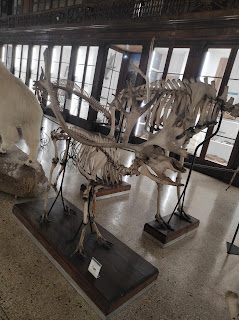The many fangs of camels

The skeleton of a dromedary at the Zoological Museum of Naples...what's up with all those fangs!? Camelids are extremely interesting and puzzling creatures, with a long list of peculiarities both in their soft and hard anatomy, including those allowing life in deserts. Today I want to talk a bit about skeletal oddities mainly, exemplified here by the skeleton of a dromedary ( Camelus dromedarius , see above photo) and the skull of a wild camel ( Camelus ferus , see below), both displayed at the Zoological Museum of Naples. UPDATE: note that according to Pietro Martini, who is cited below, the museum's labels may be wrong here: the skeleton should be that of a Bactrian camel, the skull that of a dromedary. The aforementioned wild camel skull (note that I'm following Jemmett et al. (2022) here in restricting the common name "Bactrian camel" to the domestic form Camelus bactrianus alone). You may notice the presence of multiple fangs in both the upper and lower dent...

